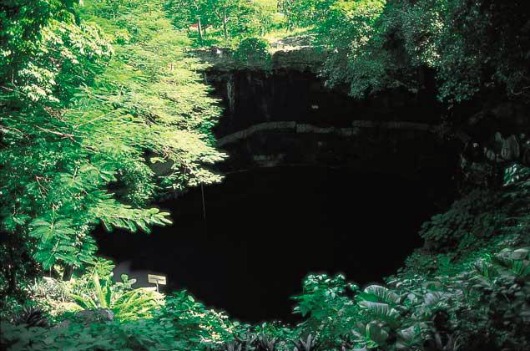A Route Through the Yucatán Cenotes

The Península de Yucatán contains more than 2,000 cenotes (a water hole unique to the region) of unbeatable beauty. Explore these incredible natural formations and discover, at the bottom of their waters, the hidden secrets of the ancient Mayans.
The Yucatán peninsula is full of fantastic water deposits and caves that were flooded during the last Ice Age, to become real time capsules in which you can observe incredible limestone formations. They are also the main freshwater source in the region, since there are no rivers on the surface and all of the water comes from underground.
There are currently more than 2,500 cenotes documented in the state of Yucatán–although it seems there could be as many as 6,000–which, when added to the 2,500 also registered in the neighboring state of Quintana Roo, suggest an existence of around 10,000 across the whole peninsula.

DAY 1: Mérida-Dzibilchaltún
Nine miles from Mérida we come across Dzibilchaltún, meaning ‘place with writing on the walls,’ one of the most important archeological sites in the state, whose first constructions date back to 500 B.C. The area covers about 10 miles, with monumental works such as the Templo de las Siete Muñecas (Temple of Seven Dolls), Plaza Central and Capilla Abierta (Open Chapel).
Next door is the Xlacah cenote, one of the largest and deepest in the Yucatán, whose name means ‘old town.’ In 1958 a diving expedition by the National Geographic Society explored its depths and rescued 30,000 Mayan objects, many of a ritual nature.

DAY 2: Mérida-Acanceh-Cuzamá
From Mérida we head towards Acanceh–‘deer’s moan’ in Mayan–, where we can visit the Gran Pirámide, a colonial church, and another modern one, all in the central plaza. At the summit of the Gran Pirámide you can observe five mascarons, their faces portraying the sun god Kinich Ahau.
From Acanceh we continue towards the town of Cuzamá, which has become famous among tourists for its cenotes and the novel way of visiting them. Outside the church you can hire a guide and his truk, a horse-drawn cart, which long ago was the mode of transport used to take sisal from the plantations to the haciendas.
The truk goes along abandoned train lines. We visited three cenotes where you can swim and practice cave diving.

DAY 3: Izamal
Now we head towards the town of Izamal to continue the expedition. An ancient center of worship to Itzamná, the supreme Mayan god, and the solar god Kinich-Kakmó, the Mayans erected five temples and pyramids in their honor. This is why Izamal is known as ‘la Ciudad de los Cerros’ (the City of Hills). In the evening, we head to Chichén Itzá to spend the night.

DAY 4: Chichén Itzá-Valladolid
We start the day exploring Chichén Itzá, the most famous and best-restored archeological site on the peninsula. This is the site of the Cenote Sagrado (Sacred Cenote). In 1900 Edward Thompson, Harvard professor and consulate of the United States, bought the hacienda where Chichén Itzá was found for 75 dollars. Intrigued upon hearing legends about maidens flung into the cenote in honor of Mayan deities, Thompson decided to dredge it, finding human bones in its waters, and gold and jade jewels from all over Mexico and as far away as Colombia. Most of these objects are now found in the Peabody Museum at Harvard, though many have been returned to Mexico.
Cenote Ik Kil
From Chichén Itzá we take the free road to Valladolid and, along the way, we stop and visit the Ik Kil cenote, located in an eco-archeological park where you will also find the ‘Sagrado Cenote Azul’ (Sacred Blue Cenote), extremely spectacular, at 85 feet (26 meters) from the surface and surrounded by dense vegetation; it has crystalline water ideal for swimming in.

Cenote Dzitnup or X’kekén, and Cenote Zací
Set inside an underground chamber, where you can see an enormous quantity of stalactites. On the ceiling there is a hole from which sunlight shines through, illuminating the turquoise blue waters. It is 4 miles south of Valladolid.
Finally, we arrive at the picturesque city of Valladolid, founded in 1543, in what was the pre-Hispanic zone of Zací–in Mayan, ‘white sparrowhawk’. The most impressive aspect of the cenote is its giant vault, home to huge hanging stalactites, through which rays of sunshine filter. Outside the cenote there is an excellent restaurant offering typical food of Yucatán.
